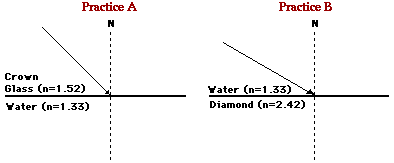

#Diffraction vs.refraction free
Free, Forced and Resonant Oscillations Free Forced and Resonant Oscillations Unless energy somehow is added to the system, dissipation eventually brings the system to rest i.e. In a real oscillating system, forces like friction are always present that dissipate the energy of the oscillator.

The oscillations whose amplitude goes on decreasing with time are called damped oscillations. For example, if the bob of a simple pendulum is displaced in a vacuum and then released, the bob executed simple harmonic motion with constant amplitude. Such oscillations can occur if frictional forces on the oscillating systems are absent. The oscillations whose amplitude remains constant with time are called undamped oscillations. They are damped and undamped oscillation. The sinusoidal oscillations can be of two types. A harmonic oscillator produces sinusoidal oscillations. Undamped and Damped OscillationsĪ system executing simple harmonic motion is called a harmonic oscillator. The positions of maximum intensity are called maxima and the superposition is called constructive interference while the positions of minimum intensity are called minima and the superposition is called destructive interference. The interference pattern consists of a region where intensity is maximum at certain points and minimum at certain points. It is characteristics of all wave motion, whether the waves are sound, light or water waves. When two frequency and amplitude overlap, this produces interference of the waves. It is observed that smaller the width of the aperture, greater is the spreading of the waves. Diffraction of water waves in a ripple tank through a small aperture is shown in the figure. However, light having small wavelength can be diffracted only through a very sharp object such as the edge of a blade and diffracting grating. This is due to the wavelength of a sound wave is nearly equal to the dimension of doors and windows. Due to diffraction of sound through the doors and windows, a sound is heard inside the room from an outside source. It is a wave phenomenon and occurs if the wavelength of the wave is of the same order as the dimension of a diffracting obstacle. Different speeds of sound produce refraction.ĭiffraction is the phenomenon of spreading of waves around the corners of an obstacles or apertures. Due to the effect, sounds are easier to hear at night than during the day times as shown in the figure. So, sound waves then tend to bend away from the ground resulting in a sound that does not seem to travel well as shown in the figure. On a warm day, the air near the ground becomes warmer than the rest of the air and the speed of sound near the ground increases. This occurs in uneven winds or when sound is travelling through an air of uneven temperatures. Soundwave bends when the parts of wave fronts travel at different speeds. Reverberation occurs after incident rays undergo multiple reflections. Since the sound wave in speech has a wavelength of various meters, they are reflected from rough surfaces such as cliffs, walls etc. The regular reflection occurs from a surface if a whole part of an incident wavefront is reflected uniformly. This can be observed in a simple experiment in which a source of sound such as a transmitter sends sound at a certain angle to the normal to a wall and a higher sound is received from reflection at the same angle on another side of the normal. Sound waves are reflected from the surfaces like light waves, obeying laws of reflection angle of incident is equal to the angle of reflection. Reflection, Refraction, Diffraction and Interference of Sound Waves Reflection Reflection


 0 kommentar(er)
0 kommentar(er)
